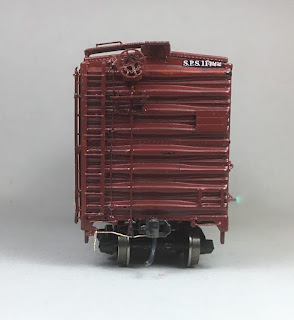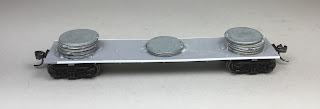Spokane, Portland & Seattle steel-sheathed box car numbered 11422 was built using Branchline Trains, Blueprint Series, kit #1431, a steel-sheathed box car kit. An excellent kit with correct Murphy rectangular panel roof, 4/4 improved dreadnaught ends, corrugated door for number series and original lettering scheme. Since I model later spring 1955 I thought that I might have to change the original lettering to replace the “Spokane, Portland And Seattle” on the right side of the door with the “football” herald; however, after input from others, I learned that was not necessary.
The prototype Spokane, Portland & Seattle (SP&S) box cars built by Pullman-Standard in 1946 were assigned to series 11000-11499. These steel cars had an inside height of 10’ 6”, five panels on each side of the 6 foot Superior seven- panel door on series 11000-11249 or Youngstown center-lift corrugated doors on series 11250-11499, 4/4 improved dreadnaught ends, eight (8) rung ladders and Murphy rectangular panel roof with metal running boards. The metal running boards depending on car number series were different. Running board types used were Apex on series 11000-11124, Blaw-Knox on series 11125-11249, Morton on series 11250-11374 and U.S. Gypsum on series 11375-11499. Trucks for these cars were ASF Ride Control A-3.
Black and white photos of SP&S 11038 and 11375 can be viewed in Railway Prototype Cyclopedia RP CYC 36, (Silverlake Images, LLC, 2023). Color photos of SP&S 11263 and 11091 can be viewed in to Spokane, Portland & Seattle Color Guide Freight and Passenger Equipment (Morning Sun Books, Inc., 1998).
 |
| Spokane, Portland & Seattle 11274 Tim O'Conner Collection (Click on this or any image to enlarge) |
I began the build of SP&S box car 11422 with the basic underbody work. On the underbody, bolster center plate and coupler pads were drilled and tapped for 2-56 screws. Kadee #262 narrow coupler gear boxes (not in kit) with Kadee #148 couplers inserted (not in kit) were installed with Fastenal 1/4” screws. The car was placed on a scale along with the roof parts to weight the car to 3.8 ounces with kit bolt nuts and electric metal box punch outs for weights. I continued installing other detail parts as follows:
- Air reservoir and brake cylinder, kit
- Control valve, resin cast in M&N Shops
- Brake levers and hangers, kit
- Slack adjuster, kit
- Piping from air reservoir to control valve, Tichy #1101 .010” PBW
- Piping from brake cylinder to control valve, Tichy #1106, .0125” diameter PBW
- Brake rods, Tichy #1106 .0125” PBW
- Brake rod clevises, MEK Goop (plastic melted in MEK)
- Chain, A-Line, #29219, black 40 links per inch
- Train line, Tichy #1114, .020” diameter PBW
- Dirt collector, InterMountain, reworked
Once detail part install was finished, Accurail trucks (replaced later) with 33” InterMountain wheel sets were installed with Fastenal 1/4” screws.
 |
| Underbody brake components installed. |
 |
| Underbody with train line and dirt collector installed. And, painted. |
With the underbody done, on the roof I installed a U.S. Gypsum running board, Kadee #2016.
 |
| Kadee U.S. Gypsum running boards installed. |
Next the ladders on the sides and ends were installed. I used the kit ladders; however, I removed the top and bottom ladder rungs and replaced them with wire ones bent using Tichy Train Group #1101, .010 diameter phosphor bronze wire (PBW). The reason for using the bent PBW rungs top and bottom was to have a secure ladder mount. A secure ladder mount was created by having the wire ladder rungs pass through the number 80 drilled ladder stiles holes into holes in the car body.
 |
| Ladders installed. |
 |
| Upper and lowest ladders rungs used to obtain a secure ladder mount. |
With ladders installed, the work on the B end was done installing parts as follows:
- Brake step, kit
- Brake step brackets, kit
- Brake housing, kit (hole enlarged with #56 drill for Kadee brake wheel)
- Bell crank, Tichy Train Group (Tichy), AB brake set #3013
- Chain, brake housing to brake rod, kit
- Brake rod, Tichy #1102, .015 diameter phosphor bronze wire (PBW)
- Brake rod clevis, to attach brake rod to bell crank, Tichy turnbuckle #8021
- Retainer valve, Tichy AB brake set #3013
- Retainer line and brackets, Tichy #1100, .008 diameter PBW
- Placard boards, kit
- Grab irons (handhold, end)bent from Tichy #1101, .010 diameter PBW
 |
| B end detail parts installed. |
Once the above B end parts had been installed I hand painted the black ends and airbrushed the black roof and underbody as painted by Branchline Trains a matching red to the sides, in this case Vallejo Model Color Burnt Red 70.814. I based the painting of the roof, ends and underbody the same color as the sides as the photos I looked at all appeared to be the same color. On the ends, I did tape over the end numbers leaving them with a black background.
 |
| Roof, ends, and underbody painted. |
And, before the B end was painted additional parts added were the bracket grab iron provided in the kit, a Kadee Ajax brake wheel, and uncoupling levers, bent from Tichy #1106, .0125 diameter PBW. The uncoupling lever mounting brackets were molded on end corner; however, without an eye bolt which was bent from Tichy, #1101 .010 diameter PBW and installed.
 |
| Note uncoupling lever bracket without eye bolt. |
 |
| Uncoupling lever installed. |
Now I went back to the sides to install the following parts:
- Doors, kit
- Placard boards on doors, kit
- Replace molded door handle with wire one, Tichy #1101, .010 diameter PBW
- Bracket grab irons (handhold, side), Kadee #2250
- Sill steps, A-LIne #29000
 |
| Side details installed. |
 |
| Side details installed. |
One more step before putting SP&S 11422 in service was to add chalk marks and weather the car with Pan Pastels. Chalk marks were made with Prismacolor Pencil Premier White PC938. Pan Pastels Paynes Grey Extra Dark 840.1 was applied with a makeup brush on the roof and lightly over safety appliances on car body.
 |
| Chalk marks and weathering applied. |
 |
| Chalk marks and weathering applied. |
 |
| Chalk marks and weathering applied. |
Spokane, Portland & Seattle Box Car 11422 was ready for service on the Minneapolis & Northland Railroad Company, The Lakeland Route, “Serving today, Shaping tomorrow.” A car card was made for SP&S 11422, the final step to put the a car in service on the Minneapolis & Northland Railroad Company Railroad. The photos of SP&S 11422 at the Commander Elevator were taken before the reweigh date was changed.
 |
| SP&S 11422 spotted at Commander Elevator in Randolph, Minnesota |
 |
| Chalk marks and weathering applied. |
 |
| Chalk marks and weathering applied. |
 |
| Chalk marks and weathering applied. |
I want to say, “Thank You”, to Tim O’Conner for providing photo of SP&S Box Car 11274. A “Thank You”, to Paul Hobbs for directing me to the SP&S Historical Society to become a member and to review their archives. And, a “Thank You”, to Ed Hawkins for data regarding features of steel cars in various number series.
Thank You for taking time to read my blog. You can share a comment in the section below if you choose to do so. Please sign your comment with your name if you choose to leave one. All comments are reviewed and approved before they appear. Please share the blog link with other model railroaders.
Lester Breuer
.
































